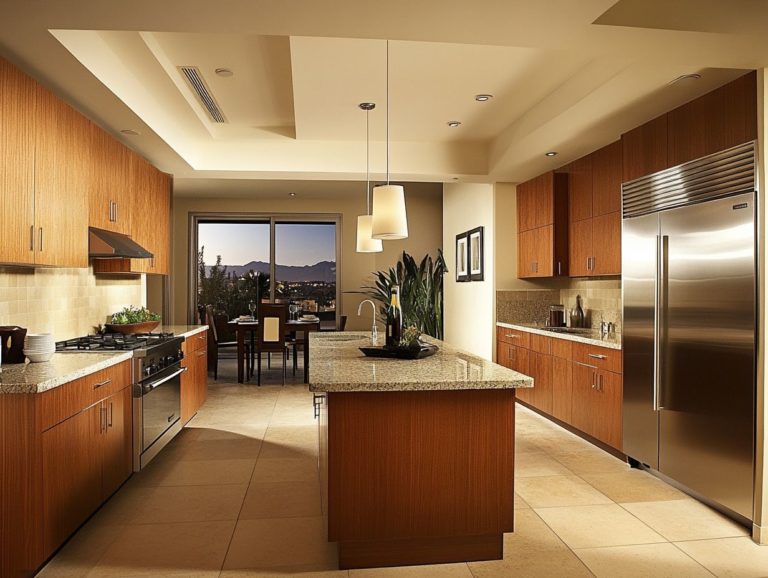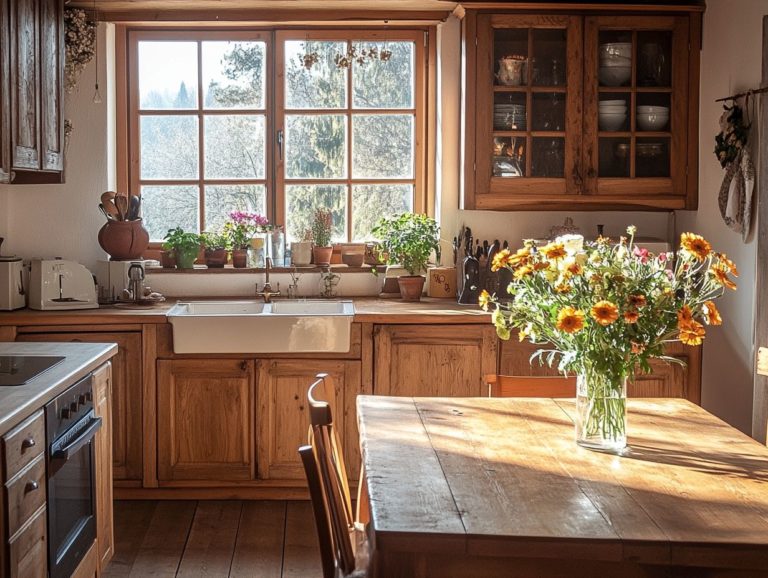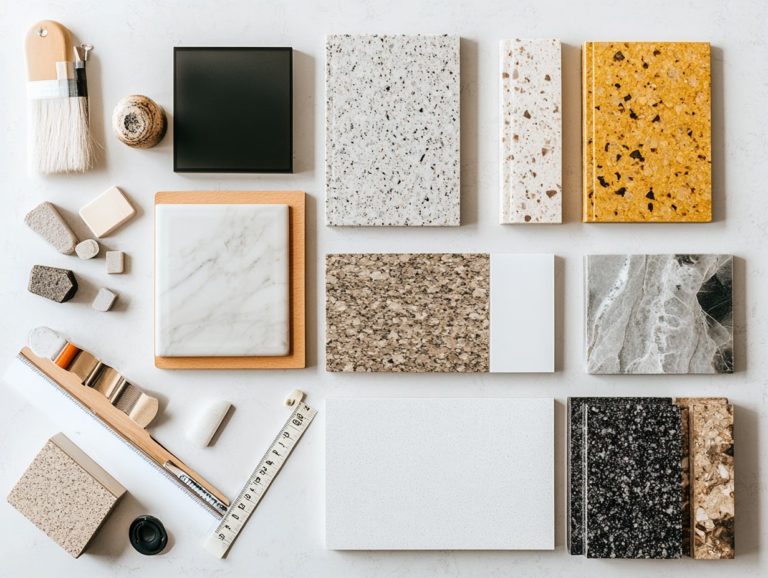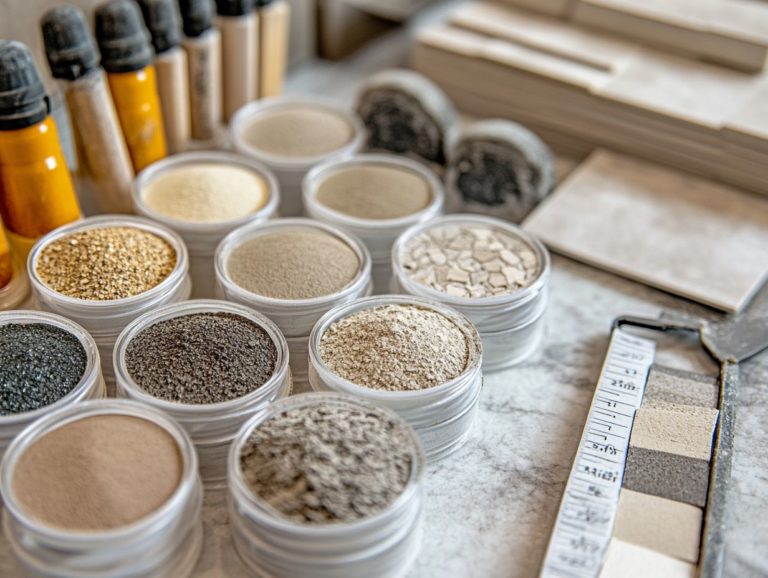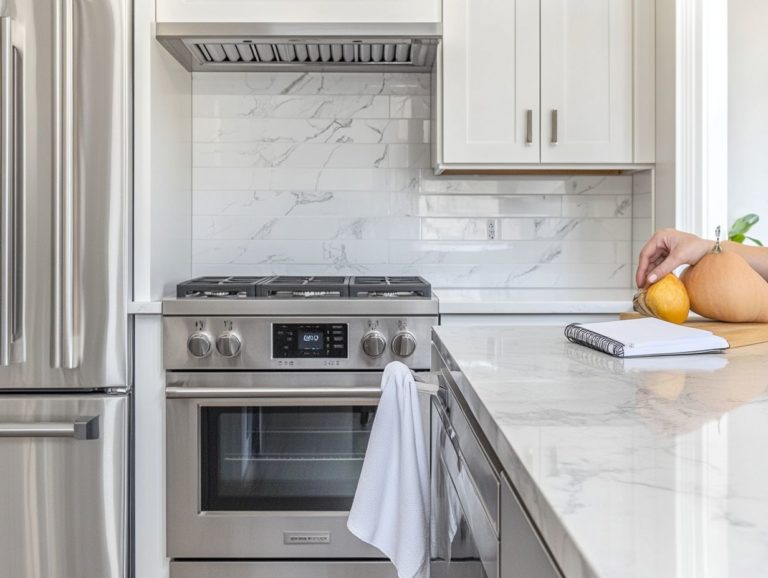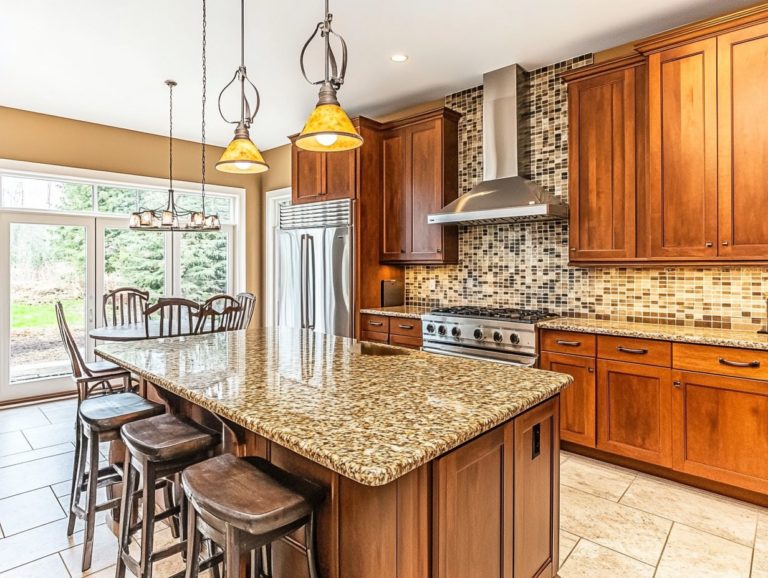5 Tips for Eco-Friendly Kitchen Renovation Materials
Renovating your kitchen goes beyond just looks; it presents an exceptional opportunity to embrace sustainable choices that enhance both your home and the planet.
By integrating eco-friendly materials and practices, you can craft a stunning space while significantly reducing your impact on the environment.
Let’s jump into five must-know tips for selecting sustainable materials, ranging from energy-saving appliances to low-VOC (volatile organic compounds) finishes.
Uncover the benefits of these thoughtful choices and witness how they can elevate your kitchen into a greener, healthier sanctuary.
Contents
- Key Takeaways:
- 1. Select Eco-Friendly Materials
- 2. Pick Energy-Saving Appliances
- 3. Choose Safe Paints and Finishes
- 4. Consider Reclaimed or Recycled Materials
- 5. Incorporate Natural Light and Ventilation
- Why Should You Consider Eco-Friendly Materials for Your Kitchen Renovation?
- How Can Energy-Efficient Appliances Help Reduce Your Carbon Footprint?
- What Are Low-VOC Paints and Finishes and Why Are They Important?
- How Can Reclaimed or Recycled Materials Be Used in a Kitchen Renovation?
- Frequently Asked Questions
- What are some eco-friendly options for kitchen renovation materials?
- Are there any affordable options for eco-friendly materials?
- How can I ensure that the materials I choose are truly eco-friendly?
- Can I still have a stylish kitchen using eco-friendly materials?
- What are some benefits of using eco-friendly materials for kitchen renovation?
- Do eco-friendly materials require any special maintenance?
Key Takeaways:
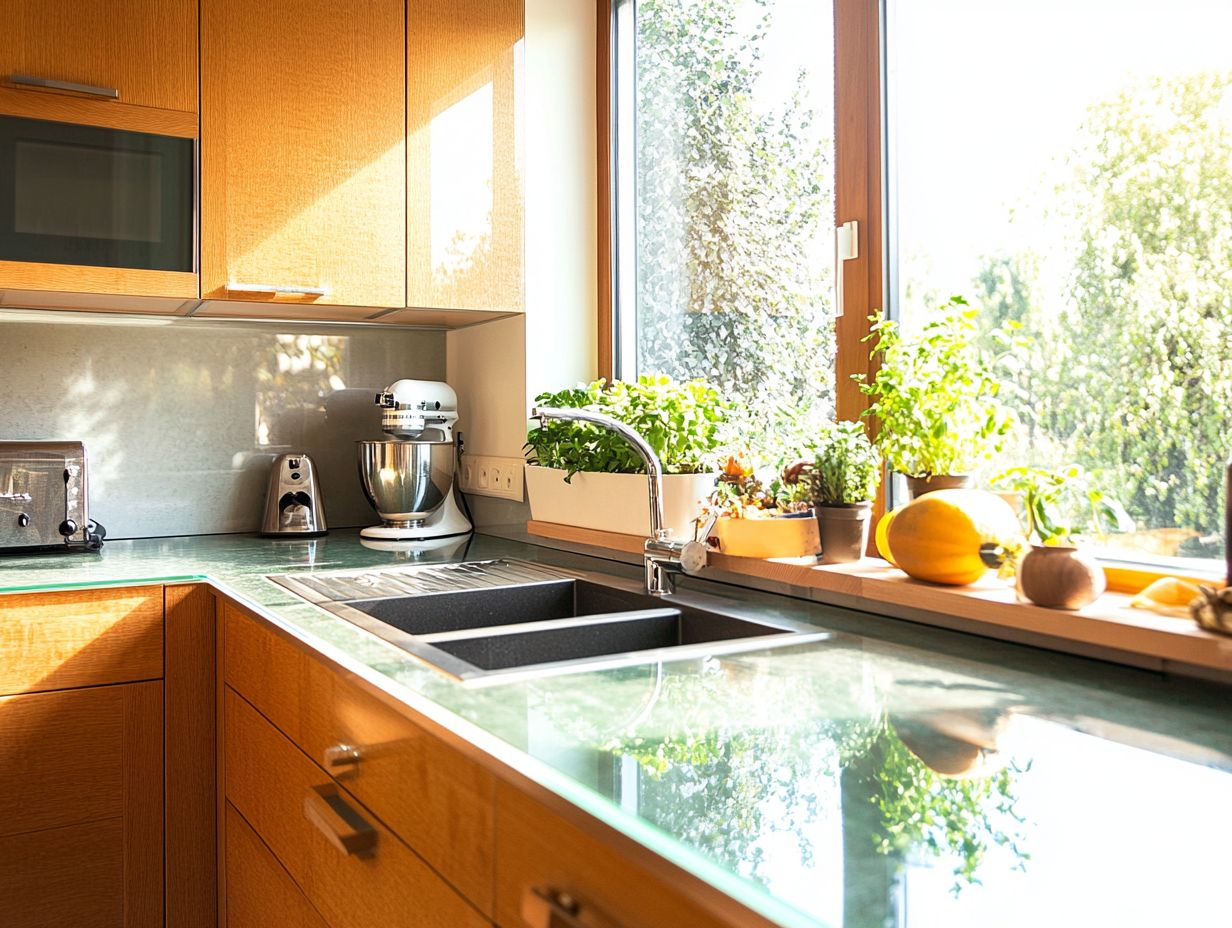
Choose sustainable materials to reduce impact and promote sustainability. Energy-efficient appliances save money and help the environment. Low-VOC paints and finishes are healthier for you and the planet, as they emit fewer harmful chemicals.
1. Select Eco-Friendly Materials
Using sustainable materials in your kitchen remodel is crucial for creating an eco-friendly home that minimizes environmental impact while enhancing durability and aesthetics.
By choosing materials like bamboo flooring, recycled components, and VOC-free paints, you can craft an eco-conscious kitchen that embodies timeless design principles and resource conservation.
Incorporating elements such as quartz countertops and eco-friendly cabinetry elevates your kitchen’s visual appeal while aligning seamlessly with green building practices.
When contemplating a sustainable kitchen renovation, consider options like reclaimed wood and recycled glass. These choices contribute to the overall aesthetic and highlight durability and waste reduction.
These materials are built to endure, ensuring that your kitchen remains both functional and beautiful for years to come.
Working with local contractors can further enhance your sourcing of these sustainable materials, as they typically have established relationships with suppliers who prioritize eco-friendly practices. This collaboration fosters a sense of community, supports the local economy, and significantly reduces the carbon footprint linked to transportation.
2. Pick Energy-Saving Appliances
Choosing energy-efficient appliances is a crucial step in crafting an eco-friendly home. These appliances consume less energy and significantly reduce your overall carbon footprint.
Opting for models certified by Energy Star guarantees superior efficiency, allowing you to save energy without sacrificing performance. This makes them an essential component of any sustainable kitchen remodel.
As you select the right options, keep in mind various types, such as:
- Energy-efficient refrigerators
- Dishwashers
- Washing machines
These appliances minimize energy usage and have the potential to lower your utility bills. They utilize advanced technology to optimize performance and enhance convenience, while the environmental benefits are remarkable; reduced energy consumption leads to lower greenhouse gas emissions.
To ensure your selections align with eco-friendly objectives, look for appliances with high energy ratings, check for available rebates, and consider the size and capacity that best suit your household’s needs.
Integrating these appliances into a comprehensive plan of energy-efficient design will streamline kitchen operations while championing sustainability.
3. Choose Safe Paints and Finishes
Choosing low-VOC paints and finishes for your kitchen renovation is essential for maintaining indoor air quality and embracing environmentally-friendly practices. These VOC-free paints significantly cut down on harmful emissions, ensuring a safer environment for you and your family while fostering a more eco-conscious kitchen.
The importance of selecting low-VOC options goes well beyond aesthetics; it plays a crucial role in enhancing your overall health by minimizing exposure to toxic substances commonly found in traditional paints. You have a range of sustainable choices at your disposal, including water-based latex paints and natural clay options, which promise quality and durability without compromise.
As you select the perfect finish, consider your kitchen’s color palette and style. Matte finishes can beautifully complement rustic design elements, while semi-gloss adds a touch of sophistication to modern aesthetics.
By making thoughtful choices, you can achieve a space that is not only stunning but also prioritizes health and well-being.
4. Consider Reclaimed or Recycled Materials
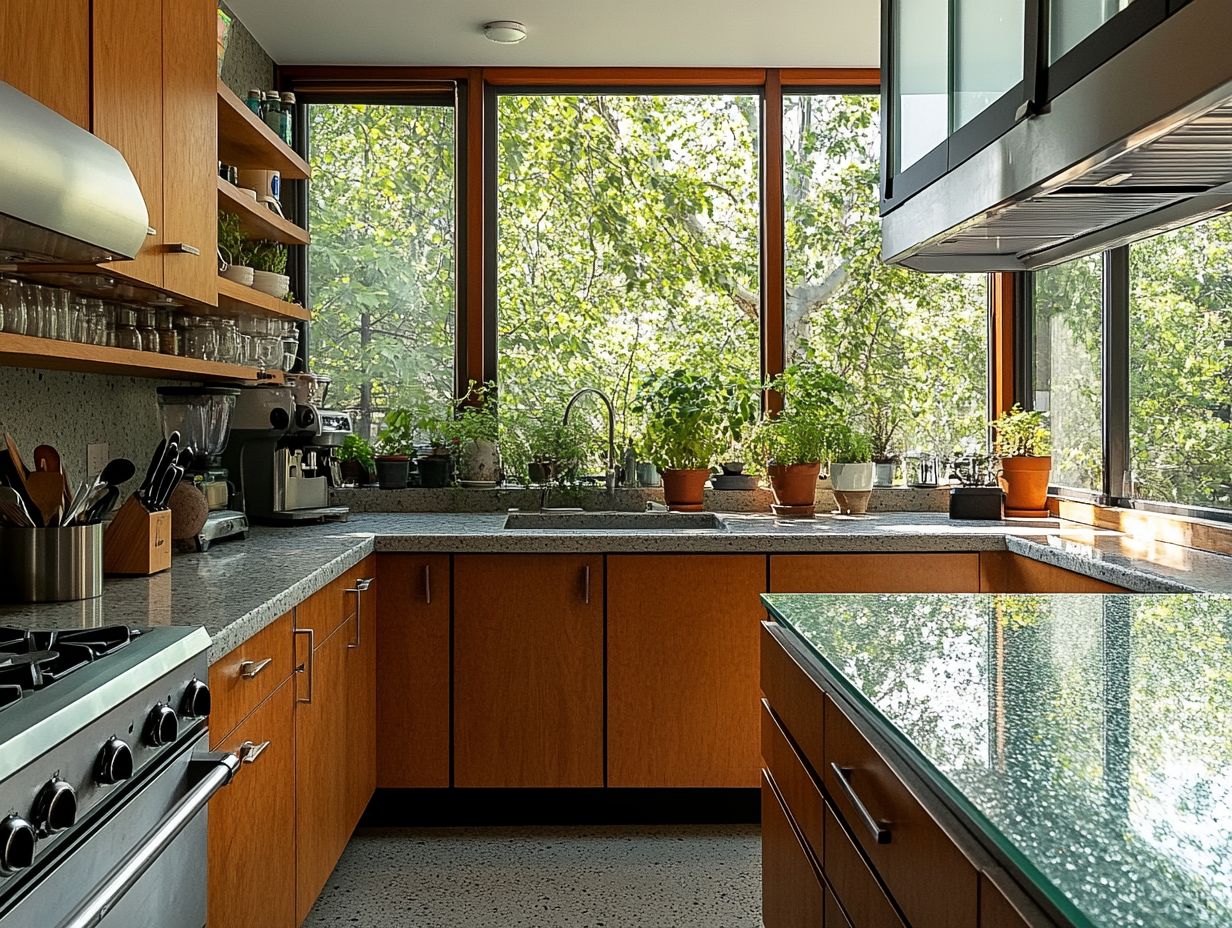
Considering reclaimed or recycled materials for your kitchen renovation is a brilliant way to make your home more sustainable while caring for the environment. By utilizing materials from Habitat ReStores or other local sources, you cut down on waste and infuse your kitchen with unique character and history.
These eco-friendly choices often boast distinctive patterns and textures that can elevate your cabinetry and countertops. Just think about it: reclaimed wood from old barns can be transformed into stunning cabinet doors, and recycled glass can create vibrant, eye-catching countertops.
Picture a kitchen where weathered timber beams evoke rustic charm alongside sleek, modern lines. It’s the perfect fusion of old and new, showcasing your commitment to sustainability.
These materials enhance the kitchen’s look and connect you to the past, transforming your renovation into a unique narrative of innovation and heritage.
5. Incorporate Natural Light and Ventilation
Incorporating natural light and ventilation into your kitchen design isn’t just a nice touch—it’s essential for enhancing energy efficiency and indoor air quality, making it a cornerstone of an eco-friendly home.
Use energy-efficient windows to maximize natural light and ventilation, which contributes to a healthier kitchen environment.
Strategically placing windows to capture sunlight throughout the day can transform the ambiance, creating a warm and inviting space that welcomes you home. Adding skylights amplifies this effect; they brighten the area and allow heat to rise and escape, promoting better airflow.
Open layouts are equally important, as they eliminate barriers that can restrict air circulation and natural light. Together, these elements harmonize to maintain optimal indoor air quality while reducing your reliance on artificial lighting and cooling systems.
This thoughtful integration elevates the kitchen’s aesthetic appeal and supports sustainable living practices, making it a savvy choice for any homeowner.
Why Should You Consider Eco-Friendly Materials for Your Kitchen Renovation?
Considering eco-friendly materials for your kitchen renovation isn’t just a fleeting trend; it’s a responsible choice that profoundly influences your home’s environmental footprint.
By selecting sustainable materials, you play a vital role in resource conservation, actively reduce your carbon footprint, and foster a healthier living environment. These eco-conscious decisions will resonate throughout your home for years to come.
Think about using reclaimed wood for your cabinets, bamboo countertops, or recycled glass tiles. Not only do these elements elevate your kitchen’s aesthetics, but they also demonstrate your commitment to sustainability. These materials are often sourced responsibly, enhancing the durability and functionality of essential kitchen features.
Picture a vibrant backsplash crafted from recycled glass, shimmering under the light, or a warm, inviting countertop made from bamboo, a fast-growing renewable resource. Each sustainable choice you make enhances functionality while creating a space that reflects a conscientious lifestyle, ultimately inspiring others in your community to reconsider their own choices.
What Are the Benefits of Using Sustainable Materials?
Using sustainable materials in your kitchen elevates its aesthetic charm and plays a crucial role in energy efficiency and durability, significantly reducing your environmental footprint. These materials are essential for resource conservation, making them a smart choice for any eco-friendly kitchen renovation project.
When you choose bamboo cabinetry or recycled glass countertops, you’re selecting options that promise lasting quality. Sustainable materials are often sourced in ways that minimize waste and energy consumption, offering the dual advantage of performance and environmental responsibility.
For example, reclaimed wood beams can infuse your space with character while ensuring structural soundness, and low-VOC paints—paints with low levels of volatile organic compounds, which are harmful gases—contribute to a healthier indoor environment.
Ultimately, these mindful decisions showcase your commitment to personal well-being and a healthier planet, making every meal prepared in such a space feel like a meaningful step toward sustainability.
Ready to transform your kitchen sustainably? Start planning your eco-friendly renovation today!
How Can Energy-Efficient Appliances Help Reduce Your Carbon Footprint?
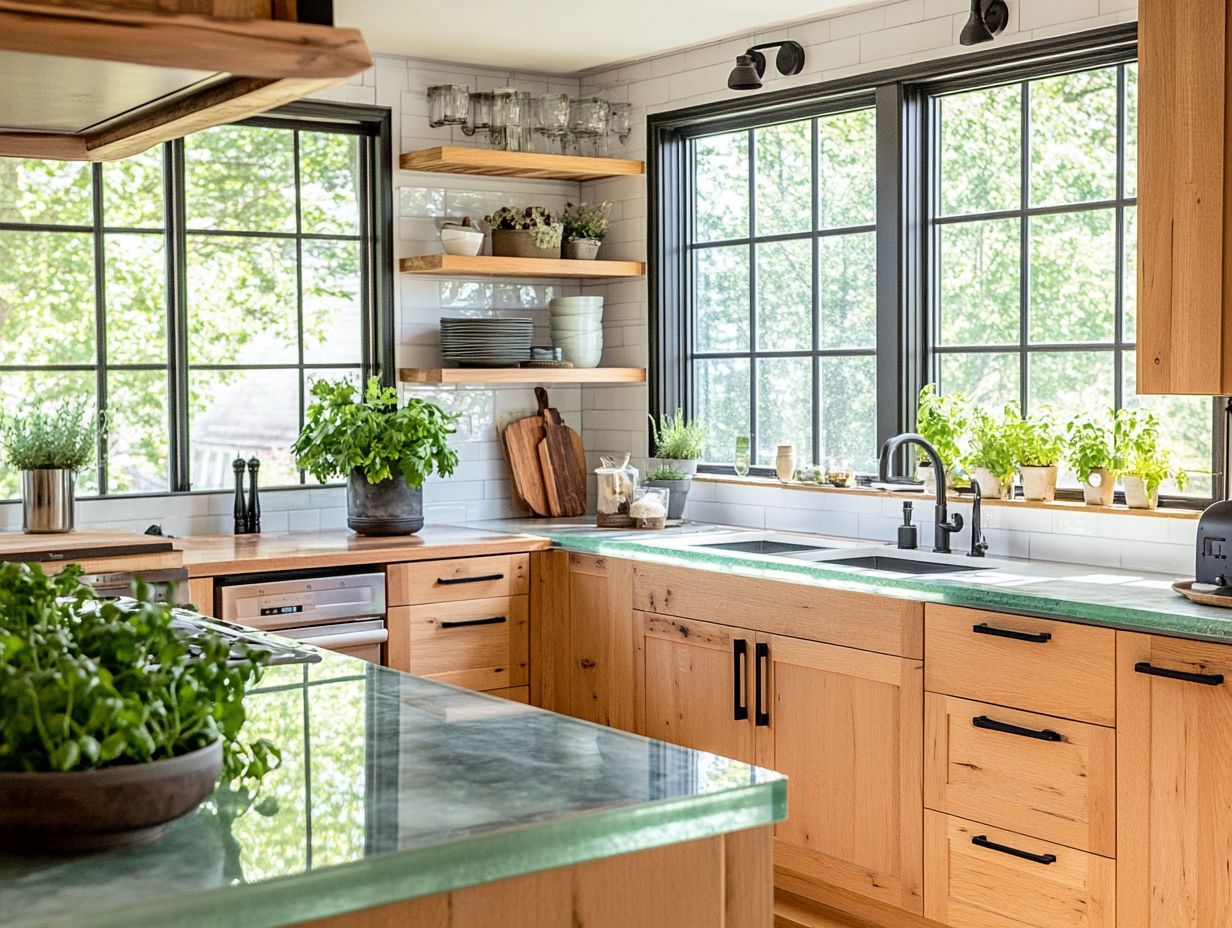
Energy-efficient appliances help you reduce your carbon footprint. They use less energy and promote eco-friendly practices in your home.
By selecting models approved by Energy Star, you ensure your appliances deliver their best performance while supporting a sustainable lifestyle.
Consider appliances like refrigerators, dishwashers, and washing machines. These items utilize advanced technologies to provide exceptional performance with lower energy requirements.
For instance, modern Energy Star refrigerators have superior insulation and efficient compressors. This enables them to maintain optimal cooling while consuming significantly less energy than traditional options.
Energy-efficient dishwashers use soil sensors to adjust water and energy use based on how dirty the load is. This guarantees that each wash is thorough and environmentally friendly.
Integrating these appliances into your daily life helps you reduce utility bills and plays a crucial role in diminishing greenhouse gas emissions. You are paving the way for a greener, more sustainable future.
What Are Low-VOC Paints and Finishes and Why Are They Important?
Low-VOC paints and finishes are crafted to minimize volatile organic compounds (VOCs), substances that can harm the air we breathe inside our homes. Choosing these paints is essential for any eco-friendly home renovation.
By opting for VOC-free options, you’ll create a safe and inviting kitchen for you and your family to enjoy. These paints significantly lower the risk of respiratory issues and allergic reactions, enhancing your living space’s comfort.
When considering your choices, take note of popular brands that emphasize low-VOC formulations, such as:
- Sherwin-Williams
- Benjamin Moore
- Behr
These companies are renowned for their dedication to sustainable practices. As you select the ideal finish, think about the sheen—how shiny or matte the paint looks—and the application method. For instance, eggshell or satin finishes provide durability while being low in VOCs.
Always scrutinize the labels for certification seals like Green Seal or GREENGUARD to ensure the paints comply with rigorous air quality standards. By choosing low-VOC paints, you’re not just decorating; you’re improving your family’s health right now!
How Can Reclaimed or Recycled Materials Be Used in a Kitchen Renovation?
Reclaimed and recycled materials can be creatively woven into various aspects of your kitchen renovation. This offers both sustainability and a unique character that sets your space apart.
Imagine using reclaimed wood for cabinetry or opting for recycled tiles for your backsplash. These choices not only help reduce waste but also infuse your sustainable kitchen with aesthetic appeal.
Incorporating elements like recycled glass countertops or salvaged metal fixtures can elevate your space’s functionality and style. For example, using reclaimed barn wood for open shelving brings rustic charm while providing the sturdiness needed for everyday kitchen items.
Choosing tiles made from recycled porcelain creates a striking visual impact without sacrificing durability. These selections beautifully illustrate how practicality and sustainability can coexist in a modern kitchen, transforming it into an eco-friendly haven that showcases both innovation and timeless appeal.
Start making sustainable choices today for a healthier tomorrow!
How Can You Use Natural Light and Ventilation in Your Kitchen?
Using natural light and ventilation can really brighten up your kitchen. It boosts energy efficiency and makes your space more inviting.
Try installing energy-efficient windows to let in more light. Consider design techniques that optimize fresh air flow, creating a healthier kitchen environment.
Skylights can fill your kitchen with sunlight. They minimize energy use and create a vibrant atmosphere.
Well-designed ventilation systems improve air circulation. This keeps your kitchen comfortable and safe for cooking and entertaining.
Frequently Asked Questions
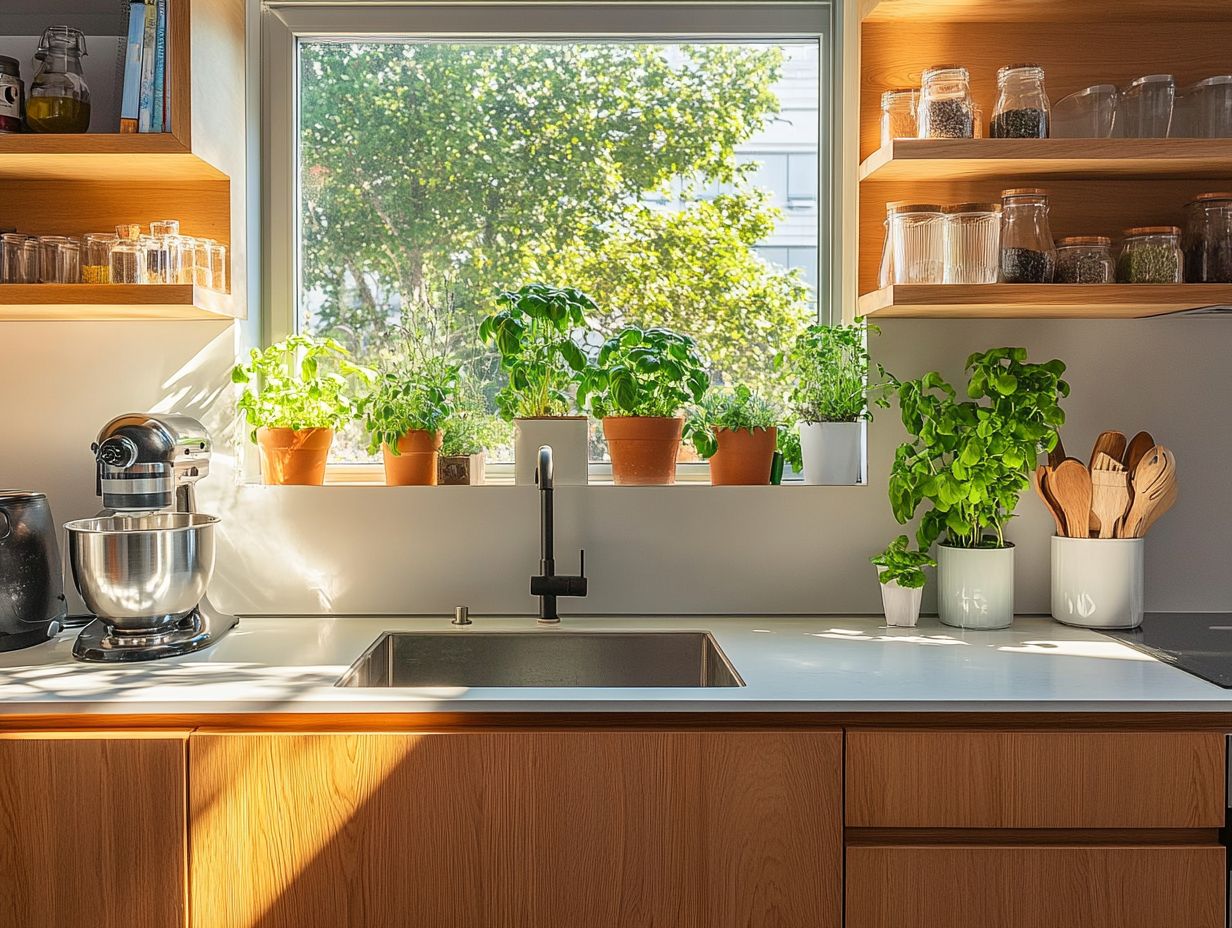
What are some eco-friendly options for kitchen renovation materials?
Look for recycled glass countertops, bamboo flooring, salvaged wood cabinets, and low VOC paints. These materials help protect the environment.
Are there any affordable options for eco-friendly materials?
Yes, bamboo is a great, budget-friendly choice. It’s a sustainable alternative to traditional hardwood flooring.
How can I ensure that the materials I choose are truly eco-friendly?
Check for certifications from organizations like the Forest Stewardship Council (FSC) or Greenguard. They confirm that products meet environmental standards.
Can I still have a stylish kitchen using eco-friendly materials?
Absolutely! Materials like reclaimed wood and recycled glass bring a modern touch to your kitchen renovation.
What are some benefits of using eco-friendly materials for kitchen renovation?
Eco-friendly materials reduce your carbon footprint. They also improve indoor air quality and create a healthier living space for your family.
Do eco-friendly materials require any special maintenance?
Most eco-friendly materials need similar maintenance to traditional ones. Some may require specific cleaning products, so check the manufacturer guidelines.
Explore eco-friendly materials today and make a positive impact on your kitchen and the environment!
